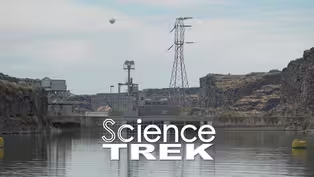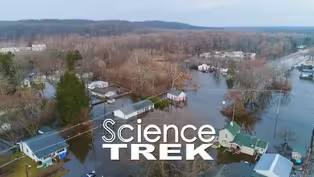
Dams: Arrowrock Dam: Inside and Out
Special | 5m 21sVideo has Closed Captions
Tour one of the world’s tallest dams, Arrowrock.
Arrowrock Dam was built in 1915, and, at the time, was the tallest concrete dam in the world. The dam was raised five feet in 1935-37 and now has a storage capacity of 272,200 feet. Take a tour inside this amazing structure and learn how dams work.
Problems playing video? | Closed Captioning Feedback
Problems playing video? | Closed Captioning Feedback
Science Trek is a local public television program presented by IdahoPTV
Major Funding by the Laura Moore Cunningham Foundation and the Idaho National Laboratory. Additional Funding by Sparklight, the Friends of Idaho Public Television and the Corporation for Public Broadcasting.

Dams: Arrowrock Dam: Inside and Out
Special | 5m 21sVideo has Closed Captions
Arrowrock Dam was built in 1915, and, at the time, was the tallest concrete dam in the world. The dam was raised five feet in 1935-37 and now has a storage capacity of 272,200 feet. Take a tour inside this amazing structure and learn how dams work.
Problems playing video? | Closed Captioning Feedback
How to Watch Science Trek
Science Trek is available to stream on pbs.org and the free PBS App, available on iPhone, Apple TV, Android TV, Android smartphones, Amazon Fire TV, Amazon Fire Tablet, Roku, Samsung Smart TV, and Vizio.

Science Trek
Science Trek is a place where parents, kids, and educators can watch short, educational videos on a variety of science topics. Every Monday Science Trek releases a new video that introduces children to math, science, technology, engineering, and math (STEM) career potentials in a fun, informative way.Part of These Collections

Technology
Technology is the practical use of science to make our lives better. Learn more.
View CollectionProviding Support for PBS.org
Learn Moreabout PBS online sponsorshipJoan Cartan-Hansen, Host: Dams are amazing works of engineering.
Let's take a tour of one of Idaho's historic dams.
[MUSIC] Student 1: Where are we going?
Student 2: To take a look at Arrowrock Dam.
[CAR DOOR SHUTS] Students: [Together] Wow!
Vicki Hoffman, Bureau of Reclamation: Hi my name is Vicki, I work with the Bureau of Reclamation.
This is Arrowrock dam.
It's the oldest storage dam on the Boise River.
And when it was completed in 1915 it was the tallest dam in the world.
It's a concrete arch dam.
That's made up of 585,000 cubic yards of concrete.
It's 359 feet high and over 1,000 feet long.
Student 1: Why did they build it?
Hoffman: They built Arrowrock dam to store water, to be used primarily for irrigation downstream.
Student 2: How do dams work?
Hoffman: Storage dams are kind of like a battery that stores power.
They hold back snowmelt and other precipitation in the reservoir behind the dam for when the water is needed later for irrigation, fish flows, recreation, power generation and other purposes.
Student 2: Can we go inside and see what's it like?
Hoffman: Sure, my friend Michael will take you.
Michael Anselme, Bureau of Reclamation: I'm very excited to show you the dam.
It's a century old and it stood as a sentinel providing irrigation water to the residents of the Boise river valley.
We're now driving along the dam's crest, which had to be raised from its original height five feet in the 1930s.
Now I'd like to take you down a hundred stairs on the exterior of the dam.
[MUSIC] Now on the inside a hundred more stairs.
Just be careful, because these are all different size and stuff.
And they're all nice and wet.
Student 1: Why are they wet?
Anselme: All concrete arch dams leak a little bit, and we measure the leakage or the amount of water seeping through the dam at the stations like this weir right here.
This measures how much water is actually seeping through.
And we're able to make a determination of whether that's normal or abnormal.
The amount of seepage indicates that we're well below, reservoir elevation, Now I'm at the actual ensign valve gallery or the upper ensign valve operating gallery.
These are also known as needle valves and the needle valves or ensign valves are the original outlets for the dam.
They allow water from the reservoir side out through to the tail water side.
Aside from the upper ensign valves the lower ten ensign valves were replaced recently with a valve called a clamshell gate.
Now, we've arrived at the upper ensign valves operating gallery and this is where we actually make the movement for the ensign valves, whether they're open or closed.
And those valves are located on the upstream face of the dam inside the reservoirs.
But these are the control mechanisms, which allow me to open and close the valve itself.
Student 2: How do you make sure the dam isn't going to collapse?
Anselme: Because of the dam of this magnitude is made with many concrete pours, we ended up with seams and the seams are a point where we'd like to monitor movement.
So, we have a ry physical feature here that allows us to see whether this dam from one side of the seam to the other has actually moved.
Now I'd like to take you down the last stairwell to the bottom of the dam.
This is called our sluice gate gallery.
This is a very long steep staircase.
So, as we go down, it gets more and more steep.
And here is Arrowrock Dam's largest stalactite.
Student 1: "A stalactite?"
Student 2 "cool!"
Anselme: Here we are at the bottom of the dam or what's known as the sluice gate gallery.
The sluice gates were a gate that was raised or lowered to release water from the reservoir.
And these are no longer operational because we're trying to prevent large releases of silt into the Boise river system below the dam.
Thank you for taking the time to join me on this tour of Arrowrock dam, the sentinel which has stood here on the Boise River serving the community for over a century.
Students: [Together] Thank you!
Cartan-Hansen: If you want to learn more about dams, check out the science trek website.
You'll find it at science trek dot org.
[MUSIC] ANNOUNCER: Presentation of Science Trek on Idaho Public Television is made possible through the generous support of the Laura Moore Cunningham Foundation, committed to fulfilling the Moore and Bettis family legacy of building the great state of Idaho.
By the Idaho National Laboratory, mentoring talent and finding solutions for energy and security challenges, by The Friends of Idaho Public Television and by the Corporation for Public Broadcasting.
Video has Closed Captions
Clip: Special | 1m 4s | Learn how dams are used to make electricity. (1m 4s)
Video has Closed Captions
Clip: Special | 1m 4s | What happens when a big dam fails? (1m 4s)
Providing Support for PBS.org
Learn Moreabout PBS online sponsorship
- Science and Nature

Explore scientific discoveries on television's most acclaimed science documentary series.

- Science and Nature

Capturing the splendor of the natural world, from the African plains to the Antarctic ice.












Support for PBS provided by:
Science Trek is a local public television program presented by IdahoPTV
Major Funding by the Laura Moore Cunningham Foundation and the Idaho National Laboratory. Additional Funding by Sparklight, the Friends of Idaho Public Television and the Corporation for Public Broadcasting.


